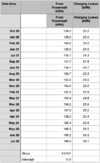Redhill_qik
Active Member
I guess this depends on how you want to look at efficiency. The PW just sitting there is losing energy due to battery leakage and running the internal electronics and cooling. This usually around 0.200-0.250 kWh per day per PW. These losses will not adjust in the exported energy number, but they will be in the imported number.I realized that this is the total efficiency which includes near term AC-DC-AC losses as well as long term degradation. If we assume that the AC-DC-AC losses are on the order of 10% then I am seeing more like 5% degradation.
If you leave the PW in standby mode and use exported/imported then you will trend towards 0%. If you are discharging to 10-20% nightly then you should tend towards 87-92% efficiency.
If you are just looking at the recharge efficiency then I use (exported - days*225*num_pws)/imported.



